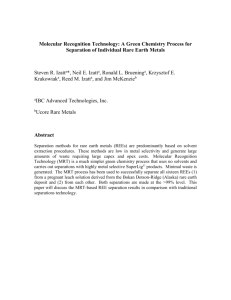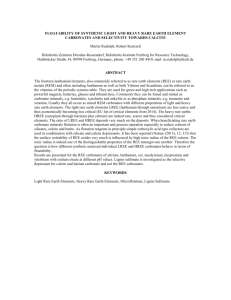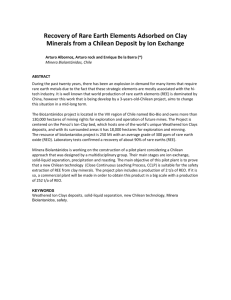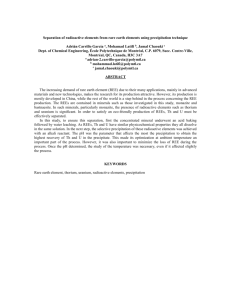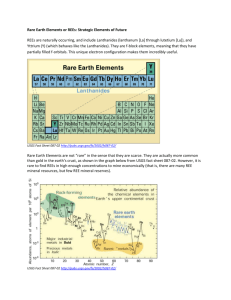Document 14081086
advertisement
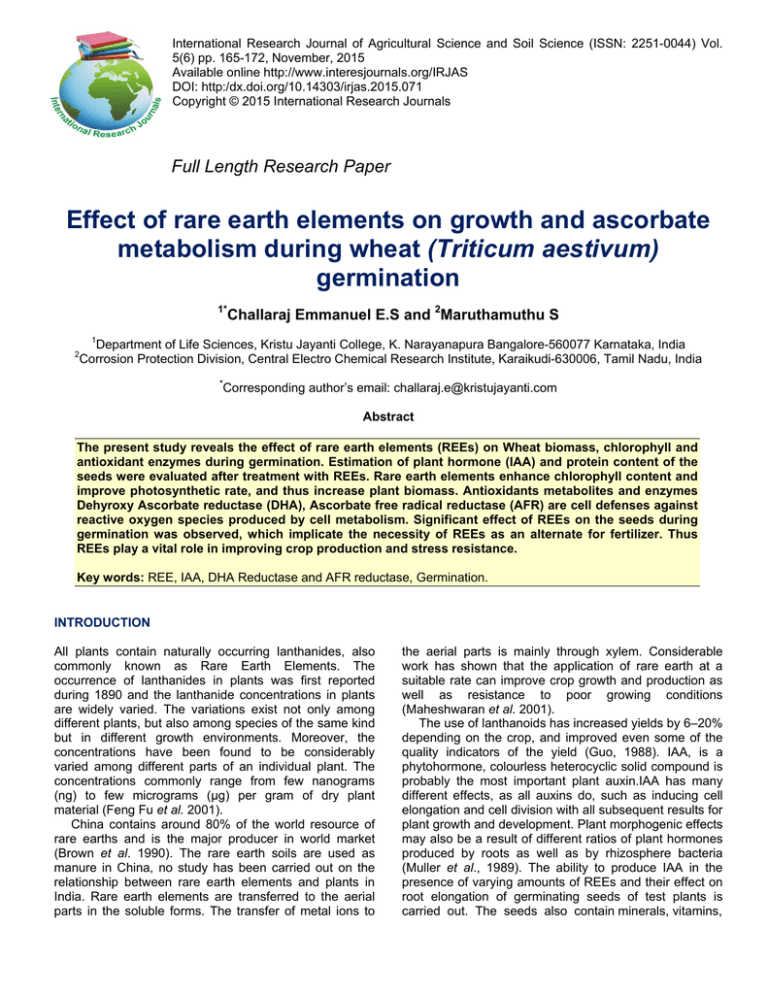
International Research Journal of Agricultural Science and Soil Science (ISSN: 2251-0044) Vol. 5(6) pp. 165-172, November, 2015 Available online http://www.interesjournals.org/IRJAS DOI: http:/dx.doi.org/10.14303/irjas.2015.071 Copyright © 2015 International Research Journals Full Length Research Paper Effect of rare earth elements on growth and ascorbate metabolism during wheat (Triticum aestivum) germination 1* Challaraj Emmanuel E.S and 2Maruthamuthu S 1 Department of Life Sciences, Kristu Jayanti College, K. Narayanapura Bangalore-560077 Karnataka, India Corrosion Protection Division, Central Electro Chemical Research Institute, Karaikudi-630006, Tamil Nadu, India 2 * Corresponding author’s email: challaraj.e@kristujayanti.com Abstract The present study reveals the effect of rare earth elements (REEs) on Wheat biomass, chlorophyll and antioxidant enzymes during germination. Estimation of plant hormone (IAA) and protein content of the seeds were evaluated after treatment with REEs. Rare earth elements enhance chlorophyll content and improve photosynthetic rate, and thus increase plant biomass. Antioxidants metabolites and enzymes Dehyroxy Ascorbate reductase (DHA), Ascorbate free radical reductase (AFR) are cell defenses against reactive oxygen species produced by cell metabolism. Significant effect of REEs on the seeds during germination was observed, which implicate the necessity of REEs as an alternate for fertilizer. Thus REEs play a vital role in improving crop production and stress resistance. Key words: REE, IAA, DHA Reductase and AFR reductase, Germination. INTRODUCTION All plants contain naturally occurring lanthanides, also commonly known as Rare Earth Elements. The occurrence of lanthanides in plants was first reported during 1890 and the lanthanide concentrations in plants are widely varied. The variations exist not only among different plants, but also among species of the same kind but in different growth environments. Moreover, the concentrations have been found to be considerably varied among different parts of an individual plant. The concentrations commonly range from few nanograms (ng) to few micrograms (µg) per gram of dry plant material (Feng Fu et al. 2001). China contains around 80% of the world resource of rare earths and is the major producer in world market (Brown et al. 1990). The rare earth soils are used as manure in China, no study has been carried out on the relationship between rare earth elements and plants in India. Rare earth elements are transferred to the aerial parts in the soluble forms. The transfer of metal ions to the aerial parts is mainly through xylem. Considerable work has shown that the application of rare earth at a suitable rate can improve crop growth and production as well as resistance to poor growing conditions (Maheshwaran et al. 2001). The use of lanthanoids has increased yields by 6–20% depending on the crop, and improved even some of the quality indicators of the yield (Guo, 1988). IAA, is a phytohormone, colourless heterocyclic solid compound is probably the most important plant auxin.IAA has many different effects, as all auxins do, such as inducing cell elongation and cell division with all subsequent results for plant growth and development. Plant morphogenic effects may also be a result of different ratios of plant hormones produced by roots as well as by rhizosphere bacteria (Muller et al., 1989). The ability to produce IAA in the presence of varying amounts of REEs and their effect on root elongation of germinating seeds of test plants is carried out. The seeds also contain minerals, vitamins, 166 Int. Res. J. Agric. Sci. Soil Sci. essential fatty acids, and phytochemicals such as polyphenols. A number of positive physiological responses have been reported in plants including faster development, larger roots, greener foliage, better fruit colour in different species (Brown et al. 1990) but the results of field trials and laboratory studies are still contradictory and inconsistent. Many agricultural practices and much research have shown that applying a controlled amount of rare earth elements (REE)-based microfertilizer enhance the yield and effectively improves the quality of crops (Diatloff et al. 1995c; Liu et al. 1997) as well as the physiological process and thus the yield is enhanced. Inductively Coupled Plasma Mass Spectrometry (ICP-MS) is the preferred method to determine the contents of REEs in soil and plant samples (Wang et al. 1997). As yet, no clear understanding has emerged regarding a process or processes which govern the magnitude or the nature of lanthanide fractionations between plants and associated soils. REEs enriched fertilizers are currently used in China from 1980’s for soil and foliar applications to enhance seed germination, root growth, chlorophyll content and plant resistance. Other studies also showed that plant growth could be increased by REEs at appropriate concentrations. REEs also increased the seedling and root growth. It has also been reported that REEs (<5 mg/L, R203) could enhance the new root growth of rice. Because of the widespread application of REE to soil and crops, interest and concern about their biological effects have been increasing. Ascorbate and glutathione are involved in a network of reactions, well known as the ascorbate-glutathione cycle. The major enzymes that participate in this cycle are AFR reductase and DHA reductase. This cycle together with other enzymatic reactions catalyzed by superoxide dismutase, catalase and peroxidase, prevent the accumulation of toxic levels of the H2O2 and other reactive oxygen species (ROS) in cell compartments (Mittler 2002). In plants treated with REE the increase of superoxide dismutase, catalase and peroxidase were also been reported (Fashui 2002; Nardi et al. 2004). The uptake of REEs in rice seeds increased dramatically after a lag period of approximately three days. Roots can accumulate a much higher content of REEs than germs and the resting seeds (Dongan et al. 2001). Applying appropriate amount of rare earth elements could not only promote seed germination and root development, increase plant biomass, but also improve harvest quality and plant resistance against stress. Rare earth elements could enhance chlorophyll content and improve photosynthetic rate, and thus, could increase plant biomass. When an appropriate amount of rare earth elements was applied, the uptake of nutrients by plant, their transformation and utilization were promoted. Also they enhance the plant resistance capability against stress. With the help of REE it is possible to influence the uptake of other nutrients. Several scientists (Guo 1988; Diatloff et al. 1996) have identified in their trials with different crops that certain concentrations of REE have a positive effect on the uptake of nutrients by roots and their movement to leaves; however, higher concentrations inhibit the uptake of plant nutrients, the growth of roots and aboveground parts and may cause damage to leaves.The present study deals with the impact of REEs on the enzymes, stress resistant product and phytohormones of wheat seeds .during germination. MATERIALS AND METHODS Seed treatment and sprouting Before sprouting, the seeds of Triticum aestivum (Wheat) were washed with 1% sodium hypochlorite. Then they were washed with distilled water to remove excess Sodium hypochlorite solution. They were soaked in REE nitrate solutions at concentrations 5, 10, 15 and 20 mM, for 4- 8 hrs then allowed to germinate in petri dishes at 20°C in the dark. They were placed in a required moisture condition for sprouting. The sprouted seeds were let to grow in sterile soil till the growth achieved to a measuring level. It was important to spray the mineral solution (Hoagland’s solution) on plants while hardening. After 6, 9 and 12 days both coleoptiles and root lengths were measured. Assessment of biomass The physical parameters are direct measurement of the wheat (Triticum aestivum) biomass (with and without treatment of REEs). The overall biomass of wheat plant was evaluated using the parameters like length of leaves, root and shoot, wet weight and dry weight of root and shoot. Batches of 4 petri dishes were incubated with 20 ml of RE 10 mM , 15 mM and 20mM respectively. MilliQ water and potassium nitrate 15 mM was used as control. After 5 days of treatment, whole plant batches (0.3 g) were collected and used for assays (Tomassi et al. 2001). Amylase activity Amylase can be assayed either by estimating the amount of reducing sugars formed or by estimating the amount of starch degraded. The substrate is starch and the product is maltose. The amount of product that is maltose formed can be estimated by DNS method. 2.5 ml of 0.1N phosphate buffer (pH 6.7) with 2.5 ml of starch solution (0.5 %), 0.5 ml of enzyme extract (seed) and 1 ml of water were mixed and the tube was incubated for 15 minutes. 0 .5 ml of 2 N NaOH was added to arrest the Challaraj and Maruthamuthu 167 enzyme activity and 3 ml of DNSA reagent (Dinitro Salicylic Acid) was added to the tube and kept in water bath for 15 minutes. The product formed (maltose) reacted with DNSA reagent and gave a colored complex. The optical density was measured at 540 nm using enzyme blank. The concentration of maltose produced was determined using standard graph for maltose. Estimation of phenols in leaves Phenols react with phosphomolybdic acid in FolinCiocalteau reagent in alkaline medium to produce blue coloured complex quantified at 650 nm. 0.5 gm of leaves were homogenized in 10X volume of 80 % ethanol, then centrifuged at 10000 rpm for 20 minutes. The residue was re extracted with 80 % ethanol; the supernatant was evaporated to dryness and dissolved in distilled water with a known volume (0.5 ml) of Folin-Ciocalteau reagent. After 3 minutes 2 ml of 20 % sodium carbonate was added and the mixture was placed on a boiling water bath for 1 minute. The amount of phenol in the extract was then quantified using a spectrophotometer at 650 nm. A standard catechol solution corresponding to 2- 10 g concentration was added with Folin-Ciocalteau reagent and sodium carbonate. A standard curve was constructed using an electronic calculator on the linear regression mode using which the concentrations of phenol in the samples were read. The values were expressed as milligrams of phenol per gram of leaf (Mallik and Singh 1980). 1:6 . The cytosolic fraction was collected (De Pinto et al. 2000) DHA Reductase and AFR reductase enzyme activities were estimated. The activity of these enzymes were tested and determined spectrophotometrically at 290 nm from the amount of trans-cinnamic acid produced upon incubation for 15 min at 40°C in a reaction mixture containing 0.1 m borate buffer, pH 8.8, 10 mm L-Phenyl alanine, and an aliquot of proteins (Sarma and Sharma 1999). Protein assay was performed according to Bradford (1976) using bovine serum albumin as a standard. Extraction and Estimation of IAA The presence of Indole Acetic Acid (IAA) in the sprouting seed (Triticum aestivum) extract was carried out (Tien et al. 1979). The sprouted seed extract was centrifuged for 10 minutes. The supernatant was collected and was adjusted to a pH of 2.8 using 20% phosphoric acid (H3PO4). Equal volume of ethylacetate was added to the filtrate and was extracted thrice. Then the ethylacetate fraction was dissolved in 2ml of methanol. IAA in the methanol extract was estimated using Salper’s reagent (1ml of FeCl3 in 50 % of 35 % perchloric acid).The optical density of the suspension was read at 535nmwith appropriate blank (2ml methanol with 4ml of Salper’s reagent) using a spectrophotometer (Gordons and Palegl 1957). RESULT AND DISCUSSION Estimation of chlorophyll in leaves Chlorophyll was extracted with 80% acetone and the absorption at 663 nm and 645 nm were read in spectrophotometer. Using the absorption co-efficient the amount of chlorophyll was calculated. One gram of leaves was extracted with 20 ml of 80 % acetone, centrifuged at 5000 rpm for 5 minutes. The supernatant was transferred to a fresh flask until the residue turned colourles. The supernatant was made up to 100 ml with 80 % acetone. The absorbance of solution was read at 645 nm and 663 nm against 80 % acetone blank and the amount of chlorophyll was estimated (Witham et al. 1971). DHA Reductase and AFR reductase enzyme assay After 5 days of treatment, whole plant batches (0.3 g) were collected and used for assays (Tomassi et al. 2001). Germinating seeds of Triticum aestivum of 5 -10 gm were homogenized in a mortar at 4C with a medium containing 0.3 % mannitol 1mM EDTA, 50mM Tris –HCl (pH – 7.8) 0.1 % BSA and 0.05 % Cysteine in a ratio of The physical parameters of the wheat biomass such as root and shoot length, fresh and dry weight of root and shoot with and without treatment of REEs were evaluated. Table 1 show a remarkable increase in root and shoot length mean value: 7.51 and 5.83 respectively, dry weight of root and shoot mean value: 0.029 and 0.026 respectively and fresh weight of root and shoot mean value: 0.091 and 0.083 respectively when treated with REEs, compared to other trials. Soaking of wheat seeds in REEs solutions of low concentrations show moderate effect, and the best effect in growth of plants was observed in seeds soaked in high concentrations. In was clearly evident by the results of the present study, greater biomass and increased root growth were observed after the exposure to different lanthanide concentrations. Total amylase, chlorophyll and phenol content in the leaves were observed to increase when treated with REEs (Table 2). The results obtained were confirmed by using statistical software Agres, version 3.01 (1994). Rare earth increased the ability of resistance of drought by maize. It also enhance the activity of plant hormones, seed germination etc. Rare earth elements enhance plant resistance and their capability against stress. They also 168 Int. Res. J. Agric. Sci. Soil Sci. Table 1: Assessment of physical parameters of wheat plant (Biomass production) S.No 1 2 3 4 5 6 7 8 9 10 Samples I II III IV V VI VII VIII IX X Mean Length of Root Shoot (cm) (cm) 8.3 5.9 6.3 6.6 8.8 3.2 9.3 5.9 5.8 7.3 8.7 7.1 5.9 6.4 8.1 3.8 9.1 5.2 4.8 6.9 7.51 5.83 With Element fresh weight of Root Shoot (g) (g) 0.08 0.07 0.09 0.08 0.1 0.12 0.13 0.1 0.07 0.06 0.06 0.09 0.1 0.06 0.09 0.10 0.15 0.1 0.04 0.05 0.09 0.08 Dry Weight of Root Shoot (g) (g) 0.02 0.01 0.03 0.01 0.02 0.04 0.05 0.03 0.02 0.01 0.04 0.03 0.02 0.01 0.01 0.05 0.07 0.04 0.01 0.03 0.02 0.02 Length of Root Shoot (cm) (cm) 6.1 3.2 5.3 2.5 5.5 4.2 6.3 4.5 7.2 6.2 6.5 3.4 4.7 2.4 5.1 4 6.4 4.7 6.7 6.4 5.98 4.15 Without Element fresh weight of Root Shoot (g) (g) 0.1 0.13 0.07 0.05 0.07 0.06 0.09 0.07 0.05 0.04 0.09 0.15 0.09 0.07 0.06 0.04 0.1 0.05 0.07 0.02 0.07 0.06 Dry Weight of Root Shoot (g) (g) 0.06 0.07 0.05 0.04 0.04 0.05 0.03 0.01 0.02 0.01 0.09 0.04 0.04 0.09 0.06 0.06 0.05 0.03 0.01 0.01 0.04 0.04 Table 2: Biochemical parameters of plant system (Wheat) Parameters Amylase activity(Units)* Total Phenols(mg/gm) Total Chlorophyll (mg/gm) With Element Without Element 2.83± 0.22 12.25 ± 0.302 1.27 ± 0.032 2.11±0.12 11.01 ± 0.52 1.07 ± 0.008 *Enzyme Activity is expressed in units; 1 unit = 1 nmol substrate utilized/ mg of protein /min. Values are mean ± SD of triplicates. Statistically significant (P<0.05) compared to untreated seeds Table 3: IAA content in sprouting seeds at various concentrations of REE Concn of REE (mM) (Control) Seeds treated water +KNO3 Seeds treated with 5 REE Seeds treated with 10 REE Seeds treated with 15 REE Seeds treated with 20 REE Seeds treated with 25 REE Optical Density at 535 nm with mM mM mM mM mM 0.14 Percentage of IAA 100% 0.09 64.2% 0.05 35.7% 0.01 7.14% - 0% - 0% improve the rate of respiration, thereby increase the photosynthesis rate and decrease the loss of water. Spraying rare earth on pepper foliars improved the total chlorophyll content of chlorophyll a, chlorophyll b. Exposure to increased concentrations of REEs show yellowing of leaves. No alterations were observed in control plants (He et al. 1998). There was a significant decrease in the concentration of IAA, (Table 3) as the concentration of REE increased. These results suggest that, moderate amount of REE Challaraj and Maruthamuthu 169 Table 4: Enzyme activity and protein content of seeds Parameters AFR Reductase (Units) DHA Reductase (Units) Total Protein Content (µg/gm of Fresh Weight of seeds) A - water + 15 mM KNO3 C- 10mM RE D- 15 mM RE E - 20 mM RE A 457±0.05 69±0.01 B 682±0.03 168±0.02 C 793±0.03 183±0.02 D 626±0.02 76±0.01 3029±0.0 4 1172±0.01 1003±0.03 945±0.01 (Control) Enzyme Activity is expressed in units; 1 unit = 1 n mol substrate utilized/ mg of protein /min. The results are expressed as the mean values of six experiments ± SD; Which indicate values significantly different respect to the control in water + KNO3 by the Student’s t test with P < 0,05 and 0,01, respectively; Figure 1a: Assay of AFR reductase activity A - Water + 15 mM KNO3 B - 10 mM RE C - 15 mM RE D - 20 mM RE would enhance the plant growth. Plant growth regulators play a critical role in plant growth promotion. Effects of plant growth regulators including IAA on the plant will be dependent on concentration. A similar change of abscisic acid content and IAA content in soybean seedlings occurred; gibberellic acid (GA) content decreased during the experiment compared with control (Qi Peng and Qing Zhou 2009). However in the present study at lower concentration of REEs, the production of IAA was higher which might exert an adverse effect on plant growth (Farah Ahamad et al. 2000). Plant-growth-promoting activity of REE is well documented. DHA (dehydroascorbic acid) reductase and AFR (ascorbyl free radical) reductase activities (Table 4) after 5 days of treatment showed an increase of DHA reductase and AFR reductase activities with lower concentrations of REEs, while the protein content decreased in plants treated with REEs (Figures 1a,1b and 1c). Rare earth elements in plants induce the metabolism as a result they are used as fertilizer in 170 Int. Res. J. Agric. Sci. Soil Sci. Figure 1b: Assay of DHA reductase activity A - Water + 15 mM KNO3 B - 10 mM RE C - 15 mM RE D - 20 mM RE Figure 1c: Assay of total protein activity A - Water + 15 mM KNO3 B - 10 mM RE C - 15 mM RE D - 20 mM RE agriculture. Metabolism of nutrients in plants increased by rare earth elements by the transfer of N from inorganic to organic form, this is a benefit for protein synthesis and regulation of nutrient balance. An increase in ascorbate and glutathione content as well as in ascorbate peroxidase, dehydroascorbate reductase and ascorbate free radical (AFR) reductase activity were observed in REE treated plants of Lemna minor (Ippolito et al. 2007) and in Triticum durum (Nardi et al. 2004). REEs treatment induced variations of the two major antioxidants, ascorbate and glutathione, as well as a remarkable increase of the activity of the enzymes Challaraj and Maruthamuthu 171 involved in their metabolism of plants. The increase of antioxidants induced by lanthanum and cerium nitrate treatment at low concentrations has been reported (Fashui 2002) in aged Oryza sativa L., where Similarly, antioxidant increase induced by lanthanum and REE nitrate treatment at low concentrations has been reported (Nardi et al. 2004) in Triticum durum. Therefore, plant response to REE seems to be dose and species dependent. Moreover antioxidant modulation in L. minor, induced by lanthanum and RE, might induce tolerance to REE exposition. A combination of IAA, GA3, and kinetin increased plant growth when the concentration of IAA and kinetin were very low (0.005 and 0.001 µg/ml, respectively). Higher concentrations of IAA and kinetin appeared to reduce growth, although differences observed were not statistically significant (Tien et al. 1979). Root hairs and lateral roots were denser. In contrast, Qi Peng and Qing Zhou (2009) suggested that the regulative effect of La (III) at the optimum concentration on endogenous hormone improved the ability of plant stress resistance. The content of IAA and GA in soybean seedlings with La (III) + UV-B treatment was higher than those of UV-B treatment. Plants respond to pure growth substances and inoculation. It seems probable that plant growth substances improve plant growth by their direct effects on metabolic processes. However, since they induce proliferation of lateral roots and root hairs and thus increase nutrient absorbing surfaces, this might lead to greater rates of nutrient absorption. This in turn would be expected to increase plant growth. It was furthermore demonstrated that rare earth elements might affect the activity of enzymes involved in antioxidant defense. Neodymium chloride was shown to increase the activity of superoxide dismutase (SOD) and peroxidase (POD), decrease malonyldialdehyde (MDA) contents, reduce membrane demagnification and enhance the ability of plants to remove reactive oxygen intermediates. Similar results were obtained for cerium (Wang et al. 1997). Additionally, neodymium increased the activity of superoxide dismutase (SOD), peroxidase (POD) and catalase (CAT) while decreasing the penetration of cell membranes. In rape the activity of peroxidase (POD) was shown to increase gradually with increasing concentrations of lanthanum (Zhang and Shang 2001). In conclusions, the REEs found to have profound impact on plant growth, enzymatic activity and stress tolerance. Finally, it has been suggested that the antioxidant potential of rare earths might be responsible for their supporting effects on stress resistance in plants. REFERENCES Agres (1994). Statistical Software Version 3.01. Pascal International Software Solutions, USA. Bradford MM (1976). A rapid and sensitive method for the quantitation of microgram quantities of protein utilising the principle of proteindye binding. Anal. Biochem. 72: 248-254. Brown PH, Rathjen AH, Graham RD, Tribe DE (1990). Rare earth elements in biological systems. Handbook on the Physical and Chemical of Rare Earths Elsevier Amsterdam. pp. 423–452. De Pinto MC, Tommasi F, De Gara (2000). Enzymes of the ascorbate biosynthesis and ascorbate-glutathione cycle in cultured cells of tobacco Bright-Yellow 2. Plant Physiol. Biochem.38: 541–550. Diatloff E, Asher CJ, Smith FW (1996). Foliar application of rare earth elements to maize and mungbean. Australian J. of Experimental Agric. 34(5): 735 – 747. Diatloff E, Asher CJ, Smith FW (1995c). Rare earth elements and plant growth: Response of corn and mungbean to low concentrations of cerium in dilute, continuously flowing nutrient solutions. J. Plant Nutr. 18 : 1991-2003. Dongan Y, Xiao-quan S, Qing H, Bei W, Xinru Z (2001). Uptake and distribution of rare earth elements in rice seeds cultured in fertilizer solution of rare earth elements. Chemosphere 43 : 327-337. Farah A, Iqbal A, Mohd SK (2000). Indole Acetic Acid Production by the Indigenous Isolates of Azotobacter and Fluorescent Pseudomonas in the Presence and Absence of Tryptophan. Turk. J. Biol. 29 : 2934. Fashui H (2002). Study on the mechanism of cerium nitrate effects on germination of aged rice seed. Biological Trace Element Research 87 : 191-200. FengFu F, Akagi T, Yabuki S, Iwaki M (2001). The variation of REE (rare earth elements) patterns in soil-grown plants: a new proxy for the source of rare earth elements and silicon in plants. Plant and Soil 235 : 53-64. Gordons A, Palegl G (1957). Quantitative measurement of indole acetic acid. Physiologia Plantarum 10 : 37-48. Guo BS (1988). Rare earth in agriculture. Beijing: China Agriculture Science and Technology Press. pp.30-150. He YZ, Wang JF, Fang NH, Gan WE, Zhao GW (1998). Effects of rare earth micro-fertilizer on plant physiological indexes and yield of hot pepper. Chinese Rare Earth 19 : 36–40. Ippolito MP, Paciolla C, D'Aquino L, Morgana M, Tommasi F (2007). Effect of rare earth elements on growth and antioxidant metabolism in Lemna minor L. Caryologia 60 : 125-128. Liu S, Wang L, Zhang S (1997). Effect of long-term foliage-dressing rare earth elements on their distribution, accumulation and transportation in soil – spring wheat system. Chin. J. Appl. Ecol. 8 (1) : 55-58. Maheswaran J, MeehanReddy JN, Peverill K, Buckingham S (2001). Impact of Rare earth elements on plant physiology and productivity. Rural Industries and development corporation, Victoria. Mallik CP, Singh MB (1980). Plant enzymology and hystoenzymology, A text manual, Kalyani Publishers. Delhi. 286 : 59-60. Mittler R (2002). Oxidative stress, antioxidants and stress tolerance. Trends in plant sci. 7 : 405-410. Muller M, Deigele C, Ziegler H (1989). Hormonal interactions in the rhizospheres of maize (Zea mays, L.) and their effect on plant development. Z. Pflanzenernahar. Bodenkd. 152 : 247-254. Nardi L, D’Aquino L, De Pinto MC, Carboni MA, Morgana M, Tomassi M (2004). Effect of rare earth elements on seed germination and antioxidant metabolism in Triticum durum. In: Proceedings of the XLVII Italian Society of Agricultural Genetics pp. D44. Qi Peng, Qing Z (2009). The Endogenous Hormones in Soybean Seedlings Under the Joint Actions of Rare Earth Element La (III) and Ultraviolet-B Stress. Biological Trace Element Research 132 : 1-3. Sarma AD, Sharma R (1999). Purification and characterization of UV-B induced phenylalanine ammonia-lyase from rice seedlings. Phytochemistry 50 : 729–737. Tien TM, Gaskins MH, Hubbell DH (1979). Plant Growth Substances Produced by Azospirillum brasilense and Their Effect on the Growth of Pearl Millet (Pennisetum americanum L.). Applied and Environmental Microbiology 37(5):1016-1024. Tommasi F, Paciolla C, de Pinto MC, De Gara L (2001). A comparitive study of glutathione and ascorbate metabolism during germination of Pinus pinea L seeds. J. of Experimental Botany 52: 1647-1654. 172 Int. Res. J. Agric. Sci. Soil Sci. Wang YG, Sun JX, Chen HM, Guo FQ (1997). Determination of the contents and distribution characteristics of REE in natural plants by NAA. J. of Radio analytical and Nuclear Chemistry 219: 99-103. Witham FH, Blaydes BF, Devlin RM (1971). Experiments in plant physiology Van.Nos. NY. pp.167-200 Zhang SZ, Shang XQ (2001). Speciation of rare earth elements in soil and accumulation by wheat with rare earth fertilizer application. Environ. Pollu. 112 : 395-405.
